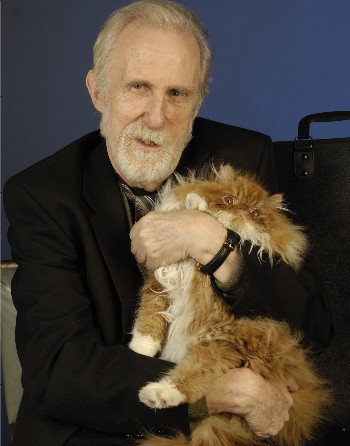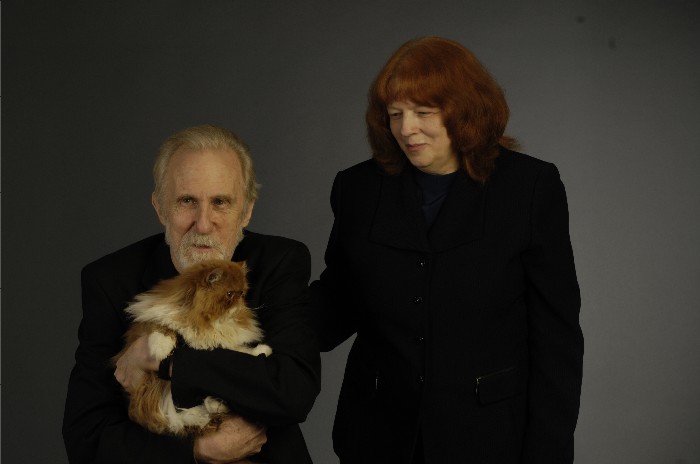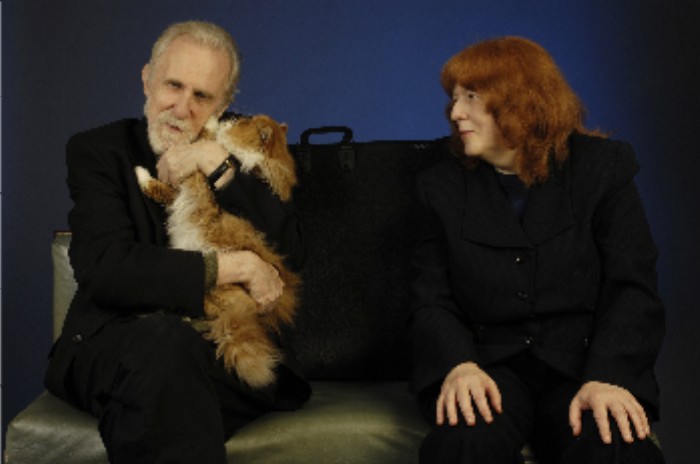Jazz Preview / Commentary: The Alla Elana Cohen – Ran Blake Project
It’s a worthy effort—and, as a listener, how many times will you have the chance for real adventure inside a concert hall?
“An Evening of Counterpoint.” Featuring Ran Blake, Alla Elana Cohen, and Darby The Red Persian Cat. At the Old South Church, Gordon Chapel, Boston, MA, June 5, 7:30 p.m.
By Steve Elman
Counterpoint, contrast, contravention, conjunction, conversation, cooperation—all those “against” and “with” words will probably apply on June 5, when composer Alla Elana Cohen presents an evening of her works featuring solo piano interludes performed by master improviser Ran Blake.
Modern musicians are far less concerned with category than are audiences, and this upcoming event is not designed as a throwdown match between “Classical” and “Jazz.” Instead, it’s a way for listeners to pull away from categories and hear each of the artists on her or his own terms. Cohen, a Russian-born composer currently on the faculty of both the New England Conservatory and Berklee, saw a natural affinity between Blake’s work and her own, and Blake was pleased to be part of the effort. The concert concept—to give each person’s music a framing provided by the other’s—is ambitious, and it offers both artistic promise and peril. It’s a worthy effort—and, as a listener, how many times will you have the chance for real adventure inside a concert hall?
I have heard Cohen’s work only via her new CD, praise Him with harp and lyre, praise Him with strings and flutes (the idiosyncratic capitalization comes from the CD cover), so I am reluctant to generalize about it. It’s probably enough to say that her two decades in Boston have been marked by increasing attention and increasing praise.
One of her greatest recent triumphs was a showcase concert at the Calderwood Pavilion of the BCA in February 2009, which won her a good deal of notice in the local press, thanks to her unusual biography. The story is told quickly—talented, Russian pianist-composer wins honors at Moscow State Tchaikovsky Conservatory, then comes under increasing scrutiny, pressure, and even physical danger because she is Jewish and a lesbian, and finally, arduously, escapes to the West in 1989, where she can no more leave her heritage behind than could Igor Stravinsky or Mstislav Rostropovich. (A propos of this, I’m reminded of a backstage interview I did with Rostropovich in the 1980s. When I asked him about whether his exile from his homeland had put him at a difficult distance from his heritage, he snorted, “Brezhnev didn’t make me Russian. God made me Russian!”)
On the new CD, Cohen’s music is by turns austere and lush, reverent and brash, warm and cool. The harmonic language is uncompromisingly modern—you will listen in vain for conventional resolutions or minimalist consonance. Her work here has more in common with that of Soviet-era Russian composers—Shostakovich, Shchedrin, Gubaidulina—than it does with the music of Old Russia. Throughout the regime of the cultural commissars, musicians (and other artists) lived in uneasy tension between official acceptance and official condemnation, and the works that grew in this half-poisoned soil share a number of characteristics. What might have been gentle satire in a European composer’s work became bitter burlesque. Themes that might have been simple and romantic were tempered with distance and suspicion. In every innovation, there was a kind of over-the-shoulder glance to see who was watching and who might disapprove. It is music that constantly compared the aspirations of the human spirit and the disappointments that come from its oppression. Cohen is both part of this milieu and an escapee from it.
Does this sound a bit like Ran Blake’s aesthetic? Irony and distance are tools that Ran has used in fashioning more than 50 years of music that is sui generis, interpretive music rooted in jazz that for the most part uses the work of other composers as a jumping-off point for his own pointed, editorial commentary, expressed in an approach to the piano that is so unusual that it lies outside any convenient categorization.
However, in one significant way, Blake and Cohen are quite different. As an American, Blake is unafraid of full-throated melody—his embrace of gospel themes, soul music, film music, and the most heart-on-sleeve examples of American popular song provides a continuing source of light within the darkness he so loves. It seems to me that Cohen wants to hold back from this kind of directness, and I don’t think it’s going too far to see the program each artist has chosen for June 5 as an example of this contrast.
Cohen’s expression of her Jewish heritage is forthright, at least in so far as her titles are concerned. But the music itself is not as directly allusive as you might suspect. The program on June 5 includes “Avinu Malkeinu,” a work for cello and piano, along with two pieces from the new CD, “Sephardic Romancero,” for string quartet, and part of Cohen’s Inner Temple series called “Writings on the Wall,” for a chamber ensemble that is mostly strings and percussion. In these pieces, the “Jewishness” is hardly overt, and in fact the “Spanishness” of “Sephardic Romancero” is soft-pedaled as well. Only the rhythm and basic melodies of the third movement of this piece have a straightforwardly idiomatic character, and even there the dissonance holds these elements at arm’s length. To me, the closing moments have the feel of “deep song,” with a subtle strumming of cello under. But this is hardly the bravura expression of the Miles Davis-Gil Evans “Sketches of Spain” or of Maurice Ravel’s “Rapsodie espagnole.”
“Writings on the Wall” is one of the most immediately communicative pieces on the new CD, and attendees at the concert will surely revel in all that percussion (timpani, vibraphone, marimba, orchestra bells) in a resonant space. The six short movements are performed without a break, and the dramatic impact of the suite is enhanced as a result. But any “Jewishness” here is decidedly internal.
Obviously considering Cohen’s interests and history, Ran Blake has decided to dive into Jewishness directly by playing Herman Yablokoff’s “Papirosn.” Blake says, “It supposedly takes place on lower Second Avenue at the beginning of the 20th century, when an adolescent boy is selling cigarettes on the street to acquire money for his starving family.” And he comments indirectly by also programming Konrad Elfers’s theme from Fritz Lang’s film Dr. Mabuse. Blake says, “Although [Mabuse is] not overtly anti-Semitic, he still could be considered the grandfather of Hitler and Stalin.”
There are more connections to be explored, but the program will undoubtedly provide a lot more detail, and why should I take away your pleasure of reading about the music when you attend?
To fill out this preview, I’d rather offer some personal guideposts—some things to listen for and some questions to ask yourself as you listen.
Pay particular attention to Cohen’s writing for strings. Her use of fretboard snaps, pizzicato, glisses and other techniques shows how effective she is at her craft and how well she knows the instruments. It also seems that string players really enjoy her music, too. On the CD, the Licata-Wood-Krentzman-Baverstam quartet gives a very committed performance of “Sephardic Romancero,” and I wouldn’t be surprised if you see smiles on the performers’ faces when you hear it on June 5. You might pay attention to the “steps on a dark street” effect in the second movement of this piece and see if Ran Blake picks up on it when he plays. And as you listen to Blake, watch his feet as much as his hands; he achieves some remarkable effects by manipulating the piano pedals, and no other pianist in any genre is so effective at shading and coloring.
Here are a few essay questions for you to ponder: How much will the juxtaposition of pieces illuminate and how much will it confuse? Will Ran Blake’s extreme use of dynamics require a lot of refocus as you move your ears from solo piano to chamber ensemble and back again? Will the rumble of outside traffic interfere with your enjoyment of Ran’s work? Will the set changes needed for each piece detract from the mood Ran establishes in his playing? Would you appreciate Cohen’s music more if the program were devoted to her work entirely, or is the use of interludes an inspired idea that you’d like to see used more often? Should Cohen direct the 14-piece chamber ensemble used in “Writings on the Wall” if she herself plays the piano part, as she does on the CD, or should she employ a conductor? And finally, will the cat steal the show?
Oh yes, the cat. A red Persian named Darby is a bit player, scheduled to make an appearance as “the featured guest.” One can only hope he has good timing.
To provide some furry context, Cohen has programmed a piece for strings from her Hoffmanniana series, called “Johannes Kreisler – Cat Murr Quintet,” apparently inspired by E. T. A. Hoffman’s satirical novel translated into English as The Life and Opinions of Tomcat Murr. For his part, Blake will play “Cat Society,” his own reworking of Alex North’s themes from Val Lewton’s film Cat People.
Who says serious music doesn’t have a sense of humor?
A note or two on the artists’ recent CDs:
praise Him with harp and lyre, praise Him with strings and flutes is on Alla Elana Cohen’s own label, as were her previous CDs. Taking control of your career from top to bottom is admirable, but when you do so, there’s no one to blame for flaws but yourself.
There are two notable recording problems here. The first is that the mastering is too hot. Like so many contemporary pop CDs, this one shows digital distortion in the volume peaks, something that results when the mastering engineer tries to put the most “punch” into the music. This is really inexcusable in a classical CD, and it especially mars the enjoyment of “Writings on the Wall,” where the dynamics are very wide. The second is the failure to adjust volume for the speakers’ parts in the two sets of pieces from Cohen’s Inscriptions on a Bamboo Screen series. She speaks the texts in one of them, and flutist Bianca Garcia does so in the other set. In both cases, the post-production could have brought up the volume of the voices so that the texts could be heard in proper balance.
Yes, this is a live recording, but the CD medium is inherently artificial; it is possible to remaster such passages effectively, and listeners would accept an increase in background noise in order to hear the words properly. With those reservations, the music itself is very worthwhile. Series 2 of Inscriptions on a Bamboo Screen is graceful and delicate. The string pieces, as noted above, are very well-rehearsed and strong. And “Writings on the Wall” makes for a fine conclusion.
Ran Blake has a new duo CD with singer Christine Correa called Down Here Below (Tribute to Abbey Lincoln, Volume 1), on Red Piano. It makes for a dramatic contrast with his last duo CD, Whirlpool (Jazz Project, 2011), featuring singer Dominique Eade. Ran’s piano sound is captured particularly well on Down Here Below, better than on Whirlpool, I think. It’s warm but resonant enough to get the proper space around his playing. On both CDs, every statement Ran makes is exquisite and his sensitivity to singers is—as it has been for 50 years—remarkable.
I have to confess that I think Eade is a more versatile singer than Correa, and so I prefer Whirlpool to the new CD. This is not to give Correa short shrift. She has a glorious, strong voice, plenty of drama, and great control of vibrato. She uses the “edges” of her voice beautifully. “Freedom Day” is brilliant from start to finish, and “Bird Alone” is particularly well-sung.
But there’s too much similarity of approach here for my ears, and I think that she uses the explosive qualities of her voice a bit too often. This becomes a significant problem in “Brother Can you Spare a Dime.” To my ears, this song wants understatement and a gradual revelation of its pathos. Ran’s solo gets this quality perfectly, but Correa’s interpretation misses the mark.
Steve Elman’s four decades (and counting) in New England public radio have included ten years as a jazz host in the 1970s, five years as a classical host in the 1980s, a short stint as senior producer of an arts magazine, thirteen years as assistant general manager of WBUR, and currently, on-call status as fill-in classical host on 99.5 WCRB since 2011. He was jazz and popular music editor of The Schwann Record and Tape Guides from 1973 to 1978 and wrote free-lance music and travel pieces for The Boston Globe and The Boston Phoenix from 1988 through 1991.





